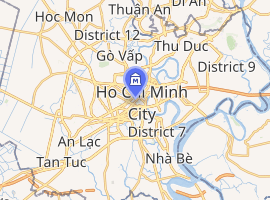War Remnants Museum
The War Remnants Museum (Vietnamese: Bảo tàng chứng tích chiến tranh) is a war museum at 28 Vo Van Tan, in District 3, Ho Chi Minh City (Saigon), Vietnam. It contains exhibits relating to the First Indochina War and the Vietnam War.
Bảo tàng chứng tích chiến tranh | |
War Remnants Museum, main building | |

| |
| Established | 1975 |
|---|---|
| Location | District 3, Ho Chi Minh City, Vietnam |
| Coordinates | 10.779475°N 106.692132°E |
| Type | War museum |
| Visitors | approx. 500,000/year (2009) |
| Owner | Government of Vietnam |
| Nearest car park | no |
History
Operated by the Vietnamese government, an earlier version of this museum opened on September 4, 1975, as the Exhibition House for US and Puppet Crimes[1] (Vietnamese: Nhà trưng bày tội ác Mỹ-ngụy). It was located in the former United States Information Agency building. The exhibition was not the first of its kind for the North Vietnamese side, but rather followed a tradition of such exhibitions exposing war crimes, first those of the French and then those of the Americans, who had operated in the country as early as 1954.[2]
In 1990, the name was changed to Exhibition House for Crimes of War and Aggression (Nhà trưng bày tội ác chiến tranh xâm lược), dropping both "U.S." and "Puppet."[2] In 1995, following the normalization of diplomatic relations with the United States and end of the US embargo a year before, the references to "war crimes" and "aggression" were dropped from the museum's title as well; it became the War Remnants Museum.[2]
Exhibits
The museum comprises a series of themed rooms in several buildings, with period military equipment placed within a walled yard. The military equipment includes a UH-1 "Huey" helicopter, an F-5A fighter, a BLU-82 "Daisy Cutter" bomb, M48 Patton tank, an A-1 Skyraider attack bomber, and an A-37 Dragonfly attack bomber. There are a number of pieces of unexploded ordnance stored in the corner of the yard, with their charges and/or fuses removed.
One building reproduces the "tiger cages" in which the South Vietnamese government kept political prisoners. Other exhibits include graphic photography,[3] accompanied by a short text in English, Vietnamese and Japanese, covering the effects of Agent Orange and other chemical defoliant sprays, the use of napalm and phosphorus bombs, and war atrocities such as the My Lai massacre. The photographic display includes work by Vietnam War photojournalist Bunyo Ishikawa that he donated to the museum in 1998. Curiosities include a guillotine used by the French and South Vietnamese to execute prisoners,[3] the last time being in 1960, and three jars of preserved human fetuses deformed by exposure to dioxins and dioxin-like compounds, contained in the defoliant Agent Orange.
Reception
The War Remnants Museum is currently one of the most popular museums in Vietnam, attracting approximately half a million visitors every year. According to the museum's own estimates, about two-thirds of these are foreigners.
US anthropologist Christina Schwenkel wrote the museum attempts to convey historical truths with 'self-representation', presenting images and other features without contextualising them as other museums do.[2] Museum curators are described as being privy to the fact that knowledge about the Vietnam War and the interests of the Vietnamese is not typically known in other nations[2].
An analysis of the impression books (which the tourists may use to leave their comments in at the exit) revealed that the museum's visitors used to be mostly Europeans and North Americans before 2005, but that its audience became much more varied after Vietnam dropped their visa requirement for ASEAN countries that year. The impression books also record mixed responses to the museum. Others simply praised Vietnam, while some Americans harshly criticized the museum for its "propaganda" and "glorification of [their] victory".[2] Broadening interests have expanded from other countries as well, including visits from tourists from Brazil, Turkey, South Africa and others expanding to see the museum[2].
Gallery
.jpg) Artillery and armor collection
Artillery and armor collection- Aircraft collection
 Defused ordnance on display.
Defused ordnance on display. Captured M41 Walker Bulldog.
Captured M41 Walker Bulldog. Relics of Vietnam War.
Relics of Vietnam War.- Guillotine used by the French.
- Diorama of alleged detention conditions in some South Vietnamese prisons
- Exhibited picture of My Lai massacre aftermath
 Display of anti-war artwork.
Display of anti-war artwork.
See also
References
- Corey Adwar (August 25, 2014). "Vietnam War Remnants Museum Portrays US As Enemy - Business Insider". Businessinsider.com. Retrieved November 17, 2016.
- Christina Schwenkel (2009). The American War in Contemporary Vietnam: Transnational Remembrance and Representation. Indiana University Press. pp. 163–167. ISBN 978-0-253-22076-9.
- "The War Remnants Museum". roughguides.com. Retrieved November 17, 2016.
External links
| Wikimedia Commons has media related to War Remnants Museum. |